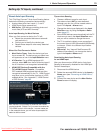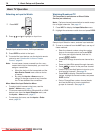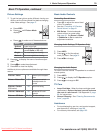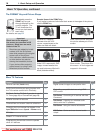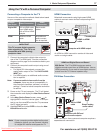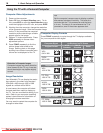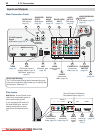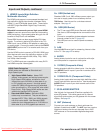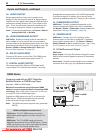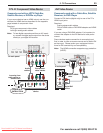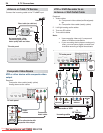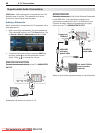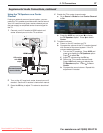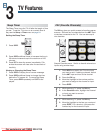
2. TV Connections 21
For assistance call 1(800) 332-2119
Inputs and Outputs, continued
1. HDMI
®
Inputs
(High-Definition
Multimedia Interface)
The HDMI inputs support uncompressed standard and
high-definition digital video formats, bitstream Dolby
Digital 5.1, and PCM digital stereo audio. These inputs
are HDCP (High-Bandwidth Digital Copy Protection)
compliant.
Mitsubishi recommends you use high-speed HDMI
cables to connect newer source devices incorporating
HDMI technology. High-speed cables bring you the full
benefits of Deep Color and x.v.Color.
These HDMI inputs can also accept digital DVI video
signals. To connect a device’s DVI output to the TV’s
HDMI input, use an HDMI-to-DVI adapter or cable plus
an analog audio. Connect the audio cable to the
DVI/PC
AUDIO INPUT
jack on the TV to receive audio from your
DVI device.
Use the HDMI inputs to connect to CEA-861 HDMI com-
pliant devices such as a high-definition receiver or DVD
player. These inputs support 480i, 480p, 720p, 1080i,
and 1080p video formats.
The TV’s HDMI inputs are compatible with many DVI-D
and HDMI computer video signals.
HDMI Cable Categories
HDMI cables are available as Standard and
High-Speed types.
High-Speed HDMI Cables.• Newer DVD
players, video games, and set-top boxes require
High-Speed HDMI cables, suitable for clock
frequencies up to 340 MHz or data rates of up
to 10.2 gigabits per second. Use high-speed
cables for 1080p HD signals carrying extended
color encodings (i.e., 30 or more bits, also called
Deep Color). High-Speed HDMI cables are also
suitable for standard HDTV signals.
Standard HDMI Cables• . Standard HDMI
cables may be unmarked. They are suitable for
standard HDTV 720p, 1080i, and 1080p signals
with 8-bit color depth. Use Standard HDMI
cables for clock frequencies up to 74.25 MHz or
data rates of up to 2.23 gigabits per second.
2a. USB (limited use)
Standard USB 5-volt, 500-milliamp power output you
can use to supply power to an accessory device.
738 Series. Use this port for a wireless network
adapter. See
page 44.
2b. USB (838 Series)
The TV can read JPEG photo files and mp3 music •
files from a USB storage device connected to this
input.
Connect a compatible wireless adapter to stream •
internet content to the TV (page 43).
This USB port can be used to power accessory •
devices.
3. LAN
Use the
LAN
Ethernet jack for streaming internet video
to the TV. See page 43 for setup.
4. AUDIO
Analog stereo inputs for use in conjunction with adja-
cent composite or component video jacks.
5. Y/
VIDEO
(Composite Video)
Analog standard-definition video inputs. Use the adja-
cent
AUDIO R
and
L
inputs if you wish to send audio to
the TV speakers.
6. Y/VIDEO Pb Pr (Component Video)
Analog video inputs able to accept high-definition video
from a high-definition source device. Use the adjacent
AUDIO R
and
L
inputs if you wish to send audio to the
TV speakers.
7. 3D GLASSES EMITTER
Use this jack for the special IR emitter supplied with
some 3D glasses. The emitter sends out an infrared
signal that synchronizes your 3D glasses with the screen
display. See page 33.
8. ANT (Antenna)
Connect your main antenna or direct cable service
(without a cable box) to
ANT
. The
ANT
input can receive
digital and analog over-the-air channels from a VHF/
UHF antenna or non-scrambled digital/analog cable
source.
Downloaded From TV-Manual.com Manuals



